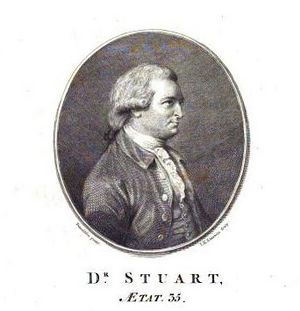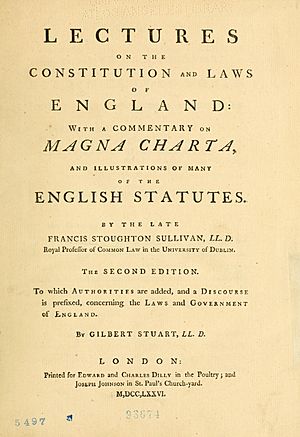Gilbert Stuart (writer) facts for kids
Gilbert Stuart (1742–1786) was a Scottish journalist and historian. He wrote many books and articles about history and government. He was known for his strong opinions and for challenging other famous historians of his time.
Early Life and Education
Gilbert Stuart was born in Edinburgh, Scotland, in 1742. He was the only son of George Stuart, who was a professor of Latin at Edinburgh University.
Gilbert went to the High School in Edinburgh. Later, he studied Classics and Philosophy at Edinburgh University. He also took a course in law, but he never became a lawyer.
Becoming a Journalist
In 1768, Stuart moved to London to start his career. He began writing for newspapers and magazines. From 1768 to 1773, he worked for a publication called the Monthly Review.
By 1773, Stuart returned to Scotland. He helped start a new magazine called the Edinburgh Magazine and Review. The first issue came out in October 1773. This magazine stopped publishing in 1776. Stuart wrote some articles for it that caused arguments, which led to the magazine closing.
Stuart often disagreed with William Robertson, another famous historian. Robertson was a leader in the Church of Scotland. Stuart felt that Robertson should have done more to support the church. In 1778, Stuart tried to become a professor at the University of Edinburgh, but he was not chosen. He believed Robertson was responsible for this.
In 1782, Stuart moved back to London. He continued his work as a reviewer. He became a main writer for the English Review, which started in 1783. From 1785 to 1786, he also helped edit The Political Herald and Review. This publication often criticized the government leaders of the time, like William Pitt.
His Important Works
Gilbert Stuart's first independent book was published in 1768. It was called Historical Dissertation on the Antiquity of the English Constitution. In this book, he explored the history of English laws and government. A second edition came out in 1770 and was very popular. Because of this work, Edinburgh University gave him a special law degree in 1769.
Stuart also helped finish the fourth volume of a book called Roman History by Nathaniel Hooke. This was published in 1771.
In 1776, Stuart added his own writings to a book by Francis Stoughton Sullivan called Lectures on the Constitution and Laws of England. He added more information and a discussion about England's government and laws.
Stuart's most famous work was A View of Society in Europe, published in 1778. This book was reprinted many times and even translated into French. In this book, Stuart followed the ideas of a famous French thinker named Montesquieu. Stuart was one of the first historians to study early Anglo-Saxon society, suggesting it had democratic ideas.
In 1779, Stuart wrote Observations on the Public Law and Constitutional History of Scotland. The next year, he published his History of the Establishment of the Reformation in Scotland. This book was about the time when Scotland changed its main religion. In 1782, he wrote The History of Scotland from the Establishment of the Reformation till the Death of Queen Mary. This book focused on the history of Scotland up to the death of Mary, Queen of Scots.
Stuart wrote his history books in a style similar to famous writers like Samuel Johnson and Edward Gibbon. He often challenged William Robertson in his writings, especially in his defense of Queen Mary.
Stuart had some supporters, like David Erskine, 11th Earl of Buchan. Buchan praised Stuart's work at the founding of the Society of Antiquaries of Scotland in 1780. Stuart's political views, which favored more freedom and less royal power (known as Whig views), were accepted by Buchan.
Death
Gilbert Stuart passed away at his father's house in Musselburgh, Scotland, on August 13, 1786.



